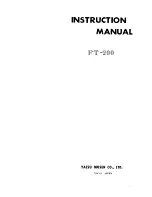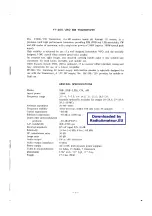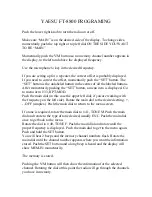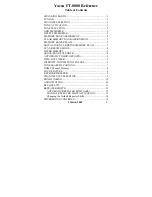
VEC-1320K/1330K/1340K/1380K Owner's
Manual
2
Additional Items:
!
RF power meter or VSWR bridge (or LED--any color)
!
50-ohm dummy load (or 1-watt 47 ohm carbon-film resistor)
!
Telegraph key outfitted with a 1/4" monaural phone plug
!
Headphones or extension speaker outfitted with a 1/4" monaural phone plug
!
13.8-v dc power source
!
Antenna cut for band of operation
BEFORE YOU START BUILDING
Experience shows there are
four common mistakes
builders make. Avoid these,
and your kit will probably work on the first try! Here's what they are:
1. Installing the Wrong Part:
It always pays to double-check each step. A 1K
and a 10K resistor may look
almost
the same, but they may act very
differently in an electronic circuit! Same for capacitors--a device marked
102 (or .001 uF) may have very different operating characteristics from on
marked 103 (or .01uF).
2. Installing Parts Backwards:
Always check the polarity of electrolytic
capacitors to make sure the positive (+) lead goes in the (+) hole on the
circuit board. Transistors have a flat side or emitter tab to help you identify
the correct mounting position. ICs have a notch or dot at one end indicating
the correct direction of insertion. Diodes have a banded end indicating
correct polarity. Always double-check--especially before applying power to
the circuit!
3. Faulty Solder Connections:
Inspect for cold-solder joints and solder
bridges. Cold solder joints happen when you don't fully heat the connection--
or when metallic corrosion and oxide contaminate a component lead or pad.
Solder bridges form when a trail of excess solder shorts pads or tracks
together (see Solder Tips below).
4. Omitting or Misreading a Part:
This is easier to do than you might think!
Always double-check to make sure you completed each step in an assembly
sequence.
Soldering Tips:
Cleanliness
and good
heat distribution
are the two secrets of
professional soldering. Before you install and solder each part, inspect leads or
pins for oxidation. If the metal surface is dull, sand with fine emery paper until
shiny. Also, clean the oxidation and excess solder from the soldering iron tip to
allow maximum heat transfer. Allow the tip of your iron to contact both the lead





































